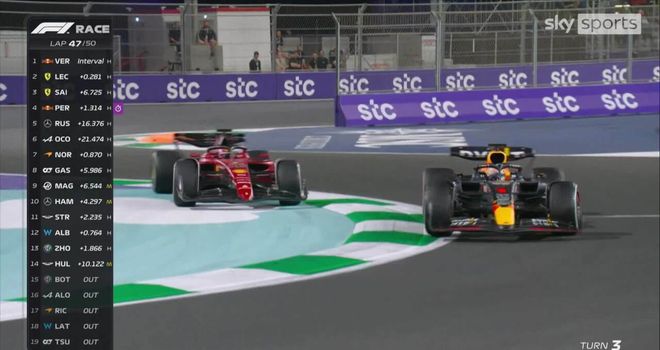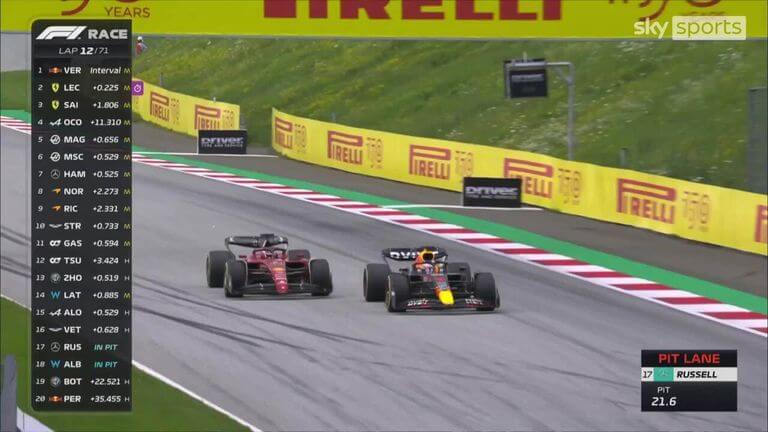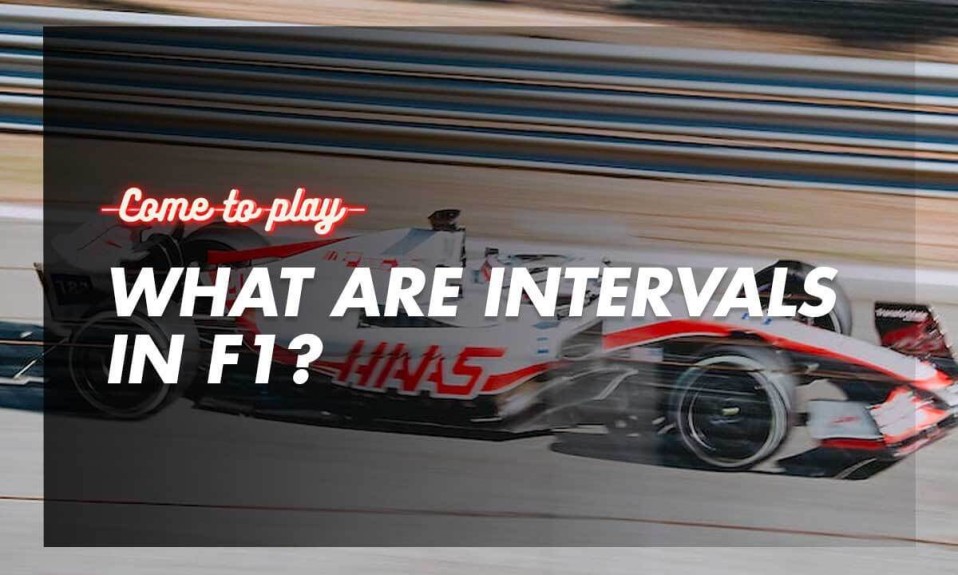At the blistering speeds F1 cars are moving, an interval of tenths a second faster than the opposition is a major advantage. How crazy does that sound, right?
But what does interval mean in F1, and why is it important? Briefly, ‘interval’ refers to the gap between two Formula 1 cars expressed in seconds.
Below we tell you all about it! Stay put!
What Are Intervals in F1?
You might have seen the word ‘interval’ on top of the live leaderboard while watching any 2-hour F1 race, but you never looked up exactly what it means.
Essentially, F1 intervals express the difference in distance between two adjacent cars, and you can find them in the numbers column next to the racers’ names.
However, while the leading car has the word next to its name, other drivers have a number next to theirs that shows how many seconds they are behind the car ahead.

For example, the image above shows that Bottas is +7.547 seconds behind Hamilton, which is over 500 meters at an average speed of about 250 kph, whereas the third-placed Vettel is trailing Bottas by +9.963 seconds—about 700 meters at the same average speed.
To determine the gap between the race leader and the third car, you must add both numbers unless the driver times are displayed cumulatively at that moment, which is not the case here. Therefore, to take the lead in the race, Vettel must make up 17.5 seconds.
Also read: What is Halo in F1?
How Are Intervals Measured in F1?

To measure any interval in F1, FIA officials use a modern system of matchbox-sized transponders placed on top of the chassis that transmit radio waves captured by timing loops in the form of thick wires installed below the track at every 150–200 metres.
This approach offers constant and precise monitoring of the car timings up to one ten-thousandth of a second (a 0 followed by four decimal places) and comes with several backup solutions, such as infrared cameras, onboard and track cameras, and light beams.
Several junctures along the course, including the start/finish line, the pit entries and exits, sector lines, and the DRS zones, also feature more and better receivers since lap times since DRS activation prompts, sector times, and pit lane times are crucial for strategy.
Interesting F1 fact: Each car emits a unique radio signal to avoid interference from other sources.
Why Are Intervals Measured in Seconds?
Since cars move at different speeds at various track sections (about 50 kph at hairpins and 350 kph on straights), the most accurate and logical approach to measuring the gaps between them is to use units of time, i.e., seconds (especially to the ten-thousandth place).
If physical distance were to be used instead, the measurements would fluctuate wildly since trailing cars get much closer to those ahead before slow corners since they are yet to slow down, but they would maintain a greater distance on straights.
You might also like: How heavy is a Formula 1 car?
Why Are Intervals Important?

Now that you know what is an interval in F1, let’s see why it is vital to the sport, as evidenced by its four principal uses:
1. Knowing the Gap to the Opposition
Accurate interval reporting is essential for teams as it gives them a clear picture of their cars’ performance at any point during the race in relation to their competitors—information crucial in devising good strategy calls and getting the most points possible.
For instance, if a driver experiences reduced pace, that might be a sign for his team to pit him for a new or different tyre set and for his opponents to go for the overtake.
2. Activating the DRS System
To activate the F1 drag-reduction system that boosts the already incredible top speed of F1 cars, drivers must be within a second of the car in front in DRS detection points.
Therefore, drivers close to each other are constantly notified about any changes in the interval gap between them since they need to know when to pick up the speed to stay ahead or get within the DRS range if leading and trailing, correspondingly.
3. Planning a Good Pit Stop Strategy
Coming into the pits at the right time and executing the right tyre strategy is crucial in finishing in front—something that even the best F1 drivers needed and will need to win.
However, completing the tyre (and other components) swapping process costs drivers between 20 to 30 seconds—a precious time loss that will see them behind several cars.
Also, teams want their cars to exit the pit lane in clear air, i.e., in front of their competition, so they can unleash their 1,000 hp F1 cars without anyone slowing them down.
Up-to-date intervals prove immensely helpful at this point since teams can exactly plan their pit lane entries and exits to give their drivers the best chance of winning.
4. Track Your Favourite Drivers at All Times
Long are the days of stopwatch interval timers when fans had no idea who was in front or by how much, and the early days of transponder tracking when there were only several time loops on the track (one for each sector), at which point the standings were updated.
Now fans will always know where their favourite drivers are, how they perform compared to others, and at which sections they are slower or faster.
Moreover, fans will immediately know if and when a driver has encountered a critical issue by seeing his name drop to the bottom or several places at once.
Related: How to become an F1 driver?
Bottom Line
The simple F1 interval definition is that it refers to the gaps between F1 cars expressed in seconds up to three (displayed) and four (measured) decimal places.
In addition to allowing fans to follow each racer closely, the system’s primary purpose is to help teams with their strategy calls and conclusively determine the position of every driver at any given time.
FAQs
What is the smallest winning interval in F1?
The closest winning interval was recorded at the Monza GP in 1971 when Peter Gethin beat 4 other cars in a thrilling photo finish where all five cars were separated by 0.06 seconds.
What is the largest winning interval in F1?
The biggest winning margin was documented during the 1969 Spanish GP when Jackie Stewart won by 5 minutes 12 seconds in front of the second-placed driver—a feat made much more impressive by the fact that he was sixth at Lap 1 and only took pole position on Lap 56.
How to read the F1 leaderboard?
Since you know what does interval mean in F1, you can easily read the leaderboard as you only need to look at the numbers next to each driver to determine by how many seconds they are behind the leader or the drivers in front of them.

